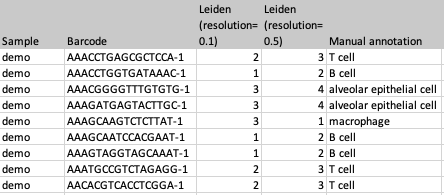Import Cell Clusters
The Import Cell Clusters tool can import clusters for each cell. The importer produces Cell Clusters (Often the same file can be imported as either Cell Clusters or Cell Annotations. The principal advantage of Cell Clusters is that they can be edited within the Dimensionality Reduction Plot.
The importer can be found here:
Import (![]() ) | Single Cell Data (
) | Single Cell Data (![]() ) | Import Cell Clusters (
) | Import Cell Clusters (![]() ).
).
The following options are available:
- Data file. A single file in .csv, .tsv or .xlsx format. The first row in the file is a header. Each subsequent row describes a cell. Empty lines are ignored.
- First column defines sample. When this is enabled, the sample name and barcode are read from the first and second columns in the file, respectively. Otherwise, the first column is used to extract the barcode and optionally the sample, as defined in Cell format. Subsequent columns represent categories containing information about the cells.
- Cell format and Sample. How cells are identified, see Cell format in importers for more details.
- Matrix (Optional). When a matrix is supplied, the sample name is taken from the matrix. If the previous options also provide sample names:
- If different from the matrix, the importer fails with an error. This can be useful when checking that the file being imported matches the supplied matrix.
- Rows in the file describing cells that are not in the matrix are skipped.
Note that the sample name can only be set using only one of the First column defines sample, Cell format, or Sample options. The Matrix option is mandatory if none of the previous options is used for defining the sample and then the matrix must be for one sample only.
- Map clusters to QIAGEN Cell Ontology. When this is enabled, clusters will be translated, if possible, to the QIAGEN Cell Ontology (see The QIAGEN Cell Ontology). The translation attempts to match each cluster with a QIAGEN cell type based on the name and known synonyms. For example, `alveolar epithelial cells' are also called `pneumocytes'. If this option is selected, the `alveolar epithelial cells' cluster, if present, will be named `pneumocytes'. This option can be useful when standardizing clusters from different sources. It is especially recommended if clusters will be used to extend a QIAGEN Cell Type Classifier using the Train Cell Type Classifier tool (Train Cell Type Classifier). See figures 4.2 and 4.3 for an example.

Figure 4.2: An example of a file that could be imported with Import Cell Clusters. The file contains three different clusterings.

Figure 4.3: The result of importing the file shown in figure 4.2 using the option `Map clusters to QIAGEN Cell Ontology'. Note that all cell types have been translated to terms in the QIAGEN Cell Ontology. For example, `T cells' have been standardized to `T lymphocytes', and `alveolar epithelial cells' have been standardized to `pneumocytes'.
